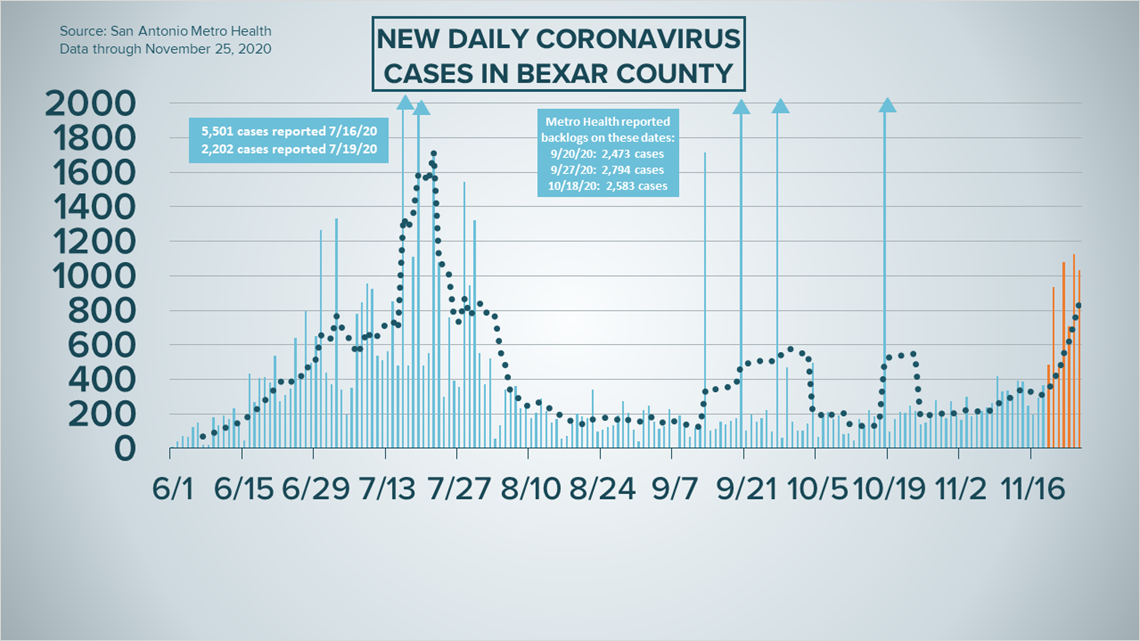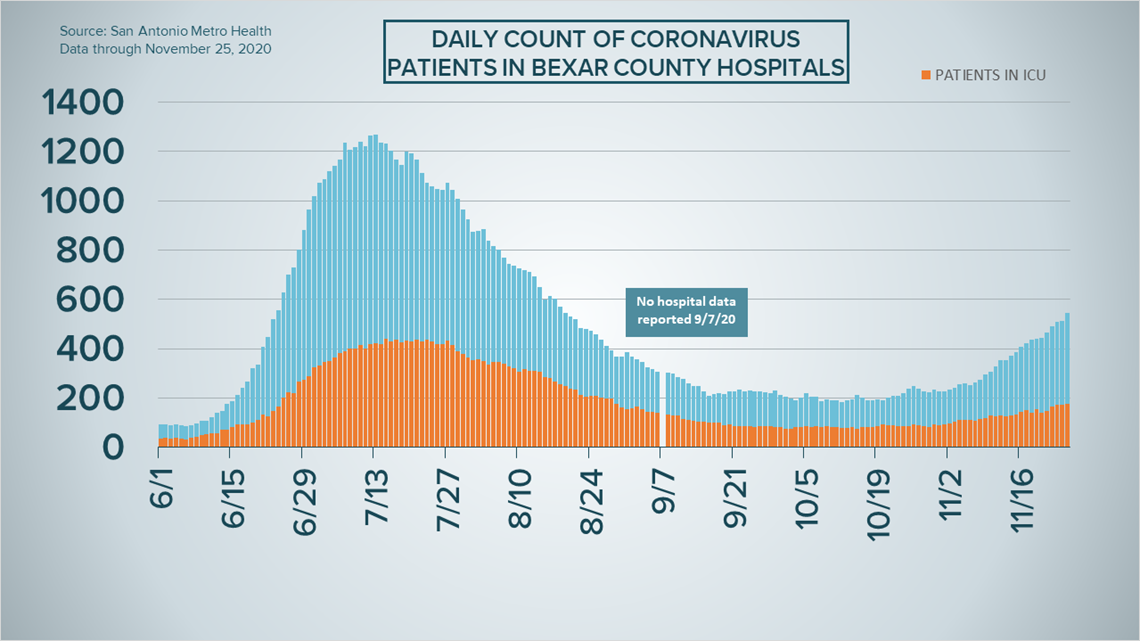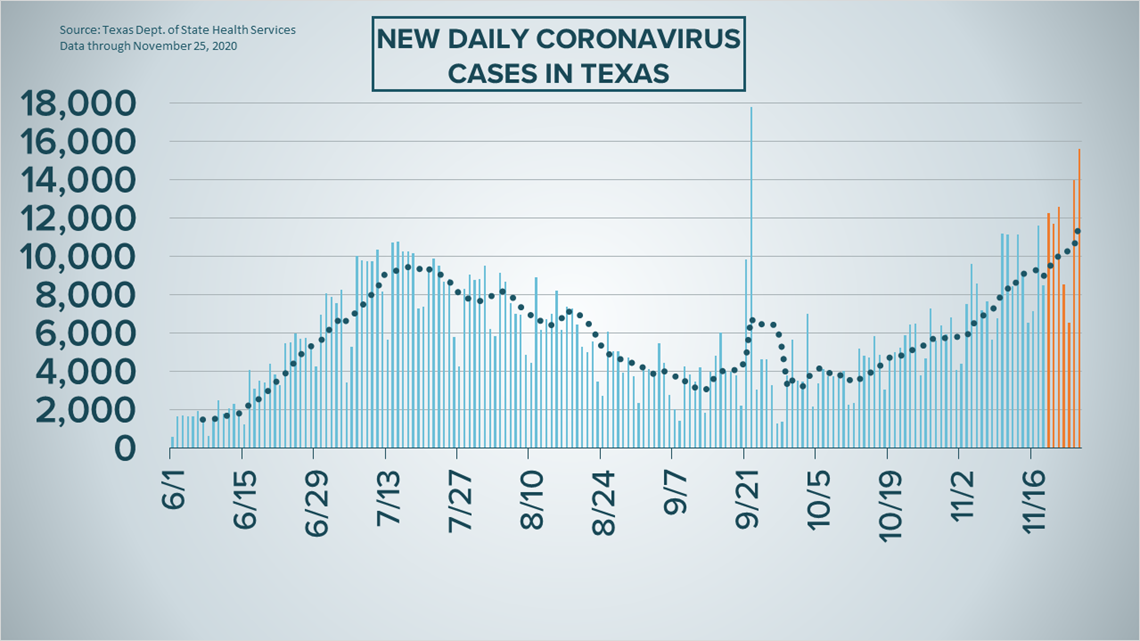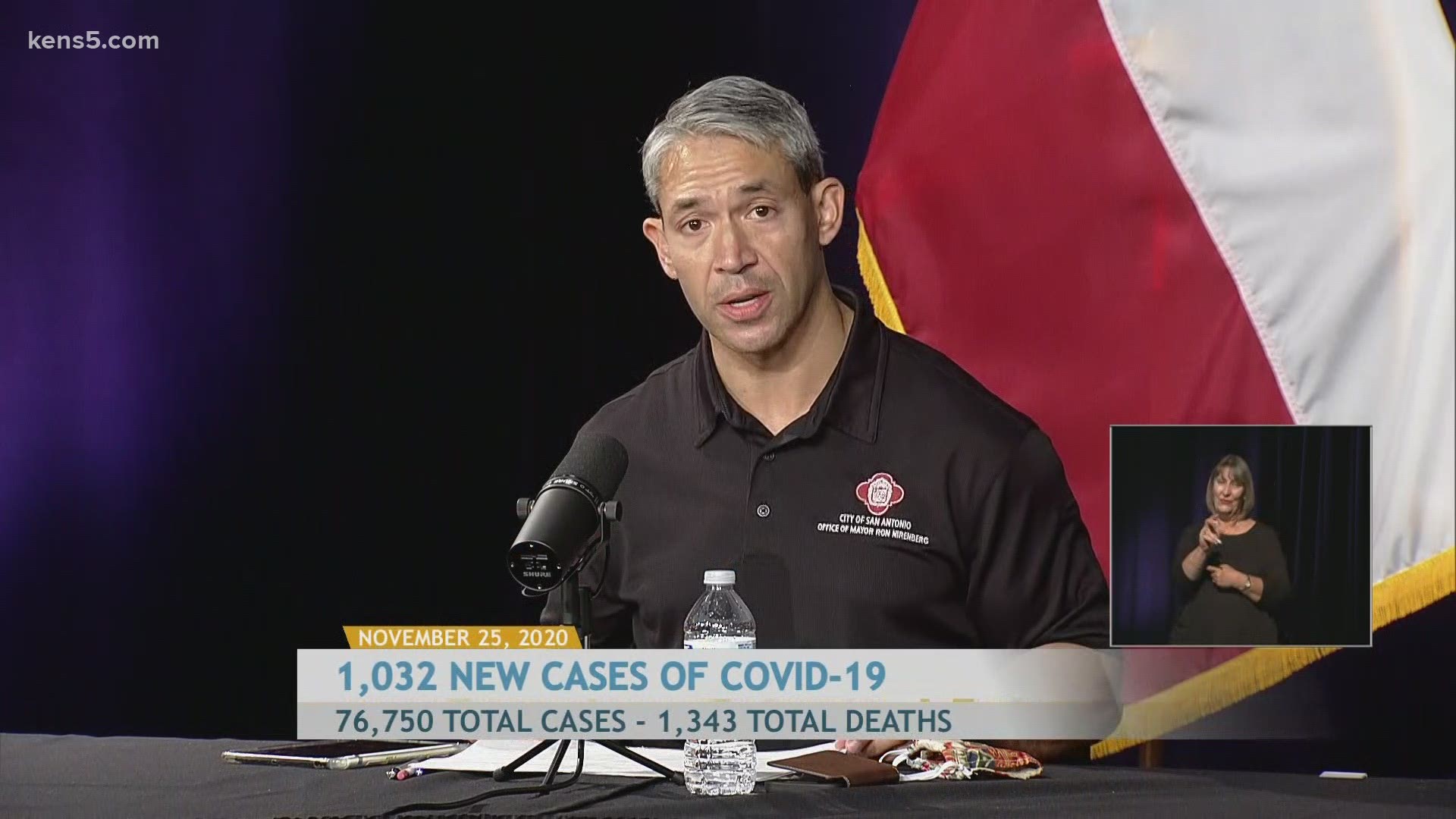SAN ANTONIO — We're tracking the latest numbers from the coronavirus pandemic in San Antonio and across Texas. Here are the latest numbers reported by Bexar and surrounding counties:
- Bexar County: 1,032 new cases were reported Wednesday, bringing the total number of cases to 76,750. Six new deaths were reported, raising the death toll to 1,343.
- Comal County: The county reported 49 new COVID-19 cases Wednesday and one new virus-related death. There have been a total of 4,467 reported cases of COVID-19 in the county – including 3,185 lab-confirmed cases – while 128 county residents have died. County officials say there are 441 active coronavirus cases, and 3,898 residents are considered recovered.
- Hays County: Officials in Hays County on Tuesday reported 55 new cases in the county and no additional COVID-related fatalities. As of Tuesday, there are a total of 7,097 lab-confirmed cases in the county (708 of which are active), while the death toll remained at 99. 6,290 residents have recovered from the virus. The county did not release new numbers Wednesday.
More county case information is available through the Texas Department of Health Services COVID-19 dashboard.
How Bexar County is trending
We've tracked how many coronavirus cases have been confirmed in Bexar County from the time officials began reporting cases in March 2020. The graphic below shows the number of cases since June and charts those daily case numbers along a 7-day moving average to provide a more accurate picture of the overall coronavirus case curve in our area and the direction we're trending amid the pandemic.
Mayor Nirenberg reported 1,032 new cases Wednesday, bringing the total number of cases to 76,750. The seven-day moving average made a considerable leap to 764 new cases per day.


Six new deaths were reported Wednesday, raising the death toll in the county to 1,343.
Hospitalizations continued to rise, with 543 patients currently in area hospitals. Of those, 88 are on ventilators and 175 are in intensive care. All of those numbers are slight increases over Tuesday.


Amid surging coronavirus numbers in Bexar County, Mayor Nirenberg and Judge Wolff implemented a curfew for the Thanksgiving holiday weekend. Beginning at 10 p.m. Thursday, November 26, residents are restricted from gathering outside their households unless they are traveling to or from an essential business. Additionally, dine-in services at restaurants are restricted until 6 a.m. the following day. The curfew will go into effect each night through Sunday, November 29.
The county's positivity rate has increased to 10%, which the county classifies as severe. The Community Response Coalition recommended Bexar County Judge Nelson Wolff last week to close bars if the COVID-19 community percent positivity is equal to or exceeds 10% for two consecutive weeks. Prior to the recommendation, Bexar County was at a 9.4% coronavirus positivity rate.
Coronavirus in Texas
The total number of novel coronavirus cases in the state since the pandemic began grew by 15,609 on Wednesday, according to the Texas Department of State Health Services. That total includes 14,648 new cases, another record for the largest single-day increase of new cases in the state in two consecutive days.
The rest are cases attributed to backlogs that were previously not included in the state's total. (More details can be found at the top of this page.)
As of Wednesday, 1.13 million Texans have contracted COVID-19.


State health authorities also reported 200 additional virus-related deaths on Wednesday. At least 20,950 Texans have died from COVID-19 complications.
The number of COVID-19-related hospital patients jumped by 90 on Wednesday up to 8,585, the highest it has been since August 4.
Since the start of October, the number of Texas hospitalizations has increased by 169%. Meanwhile, the state estimates that 935,011 Texans have recovered, while 177,573 Texans remain ill with COVID-19.
The latest update from the Texas Education Agency showed that there have been 50,420 cumulative cases among staff and students across the state through Nov. 15. More information can be found here.
The TEA releases new data on school cases every Thursday.
Latest Coronavirus Headlines
- Bexar County placed under partial curfew through Thanksgiving weekend
- Texas sets another daily record for number of new COVID-19 cases
- Dallas meatpacking plant which lost 2 workers to COVID-19 outbreak faces more than $25,000 in fines
- Food insecurity is bad in Texas but in San Antonio, it's worse
- Defying warnings, millions in the US travel for Thanksgiving
- Congress braces for Biden's national coronavirus strategy
- Texas shut down bars to slow the spread of coronavirus, but allowed thousands to open through a restaurant loophole
- US jobless claims rise to 778,000 as pandemic worsens
- EU says first coronavirus vaccinations possible by Christmas
Coronavirus symptoms
The symptoms of coronavirus can be similar to the flu or a bad cold. Symptoms include fever or chills, cough, shortness of breath or difficulty breathing, fatigue, muscle or body aches, headache, new loss of taste or smell sore throat, congestion or runny nose, nausea or vomiting and diarrhea, according to the Centers for Disease Control.
Most healthy people will have mild symptoms. A study of more than 72,000 patients by the Centers for Disease Control in China showed 80 percent of the cases there were mild.
But infections can cause pneumonia, severe acute respiratory syndrome, kidney failure, and even death, according to the World Health Organization. Older people with underlying health conditions are most at risk.
But infections can cause pneumonia, severe acute respiratory syndrome, kidney failure, and even death, according to the World Health Organization. Older people with underlying health conditions are most at risk.
Experts determined there was consistent evidence these conditions increase a person's risk, regardless of age:
- Chronic kidney disease
- COPD (chronic obstructive pulmonary disease)
- Obesity (BMI of 30 or higher)
- Immunocompromised state (weakened immune system) from solid organ transplant
- Serious heart conditions, such as heart failure, coronary artery disease, or cardiomyopathies
- Sickle cell disease
- Type 2 diabetes
The CDC believes symptoms may appear anywhere from two to 14 days after being exposed.
Human coronaviruses are usually spread...
- Between people who are in close contact with one another (within about 6 feet).
- Through respiratory droplets produced when an infected person coughs, sneezes or talks. These droplets can land in the mouths or noses of people who are nearby or possibly be inhaled into the lungs.
- Some recent studies have suggested that COVID-19 may be spread by people who are not showing symptoms.
Help stop the spread of coronavirus
- Stay home when you are sick.
- Eat and sleep separately from your family members
- Use different utensils and dishes
- Cover your cough or sneeze with your arm, not your hand.
- If you use a tissue, throw it in the trash.

